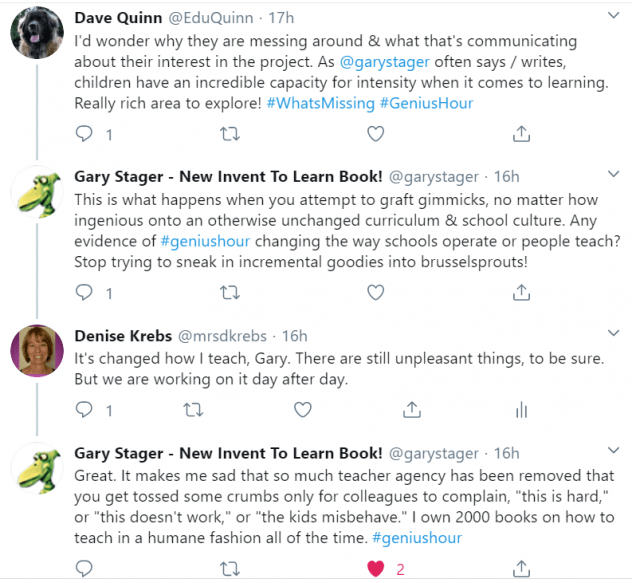I woke up at 3:00 a.m. this morning. Hmmm…Will I go back to sleep? I wondered. I didn’t think so, but I brought my pillow and alarm clock out to the living room. I got myself cozy reclining on the Lazy Boy and tried to sleep for another hour. I couldn’t, so I sat up and started working. It helped me wake up enough to get ready for the #GeniusHour chat. That’s the once-a-month chat I always try to join at 5:00 a.m. in the winter. (Next month, it will start being at 4:00 a.m. Arabia Standard Time.)
Anyway, I was excited this morning. Dave Quinn was leading us in questions about the role of teacher during the Genius Hour experience. I was there to welcome people, and introduce Dave, though he didn’t need introduction. He’s led us before and been at other chats. Anyway, I made it and was awake enough, even if my Internet was sluggish.
At the end of the chat, one of the last mentions I noticed was from Gary Stager. The first time I “met” him was in a workshop at the Iowa Technology in Education Conference in 2011. He was the speaker and I was a fan in the audience. When I searched my blog, his name came up on six posts. In all my experience with him, I would describe Gary as a provocateur. He has provoked me to think many times, and he did again today. During the chat Dave quoted him and mentioned him in the following tweet. Some provocative tweets followed.
My whimpering response, “It’s changed how I teach, Gary.”
Then when the chat finished, I went back to bed, but I didn’t sleep. We had such a nice chat, and then that Pterodactyl came and…and…and…
What? Really, Denise? What did he do? Hmmm…I had to think about that.
He didn’t agree? Maybe. Was I upset or sad because he didn’t agree with us, he wasn’t as excited about Genius Hour as we were? When I realized those last thoughts, I stopped and considered the importance of provocations in my life. I don’t appreciate agree-ers. I need people to push me, to challenge and disagree and tell me why. It’s always how I have grown.
Hebrews 10:24 says, “And let us consider how we may spur one another on toward love and good deeds.” The verb “spur on” in the Greek is paroxusmos and literally means to come alongside and jab into action, in this case jab “one another on toward love and good deeds.”
I thought about Gary’s jabs. He came alongside this morning and gave us a jab. Maybe on some level toward the same thing the Bible is talking about–love and good deeds. He jabs us toward loving students, jabs us toward giving ownership of learning back to those who are most qualified to own it–the learners. He jabs us into action to discover how we can make school good, really good. He jabs us to make education more humane and school curriculum and culture the best, and not to settle for less.
The hour is late, and I will now go back to bed and probably think more about these things. Another post soon about jabbing, but also coming alongside.
